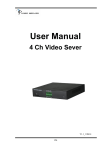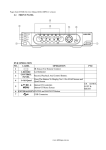Download User Manual - Channel Vision Technology
Transcript
User Manual 4-Channel Video Server W-4001 1/35 Version B WARNINGS TO REDUCE THE RISK OF FIRE OR ELECTRIC SHOCK, DO NOT EXPOSE THIS PRODUCT TO RAIN OR MOISTURE. DO NOT INSERT ANY METALLIC OR ELECTRIC CONDUCTIVE OBJECTS THROUGH THE VENTILATION GRILLS. CAUTION CAUTION RISK OF ELECTRIC SHOCK DO NOT OPEN CAUTION: TO REDUCE THE RISK OF ELECTRIC SHOCK: DO NOT REMOVE COVER (OR BACK). NO USER-SERVICEABLE PARTS INSIDE. REFER SERVICING TO QUALIFIED SERVICE PERSONNEL. COPYRIGHT THE TRADEMARKS MENTIONED IN THE MANUAL ARE LEGALLY REGISTERED TO THEIR RESPECTIVE COMPANIES. 2/35 Content I. PREFACE ....................................................................................................................................... 4 II. PRODUCT SPECIFICATIONS ....................................................................................................... 4 III. PRODUCT INSTALLATION ........................................................................................................... 6 A. MONITOR SETTING........................................................................................................................ 6 B. HARDWARE INSTALLATION ............................................................................................................. 7 C. IP ASSIGNMENT ............................................................................................................................ 9 D. INSTALL ACTIVEX CONTROL (SET-UP ONCE ONLY):......................................................................... 13 IV. LIVE VIDEO .................................................................................................................................. 15 V. VIDEO SERVER CONFIGURATION............................................................................................ 17 A. SYSTEM ..................................................................................................................................... 18 B. NETWORK .................................................................................................................................. 21 C. MULTIMEDIA ............................................................................................................................... 26 D. EVENT........................................................................................................................................ 30 VI. FACTORY DEFAULT.................................................................................................................... 34 VII. PACKAGE CONTENTS ............................................................................................................... 34 APPENDIX I .......................................................................................................................................... 34 3/35 I. Preface This is a 4-Channel H.264/ MJPEG Video Server with a web server built-in. It encodes analog signals of traditional cameras to digital signals, allowing the users to monitor real-time video via IE Browser. The H.264 and MJPEG compression format supports smooth video quality. It also supports SD Card backup and 2-way audio, which enables the user to have a video conference. In addition, the user can control the Video Server with a user friendly interface via IE Browser to build a home surveillance system. II. Product Specifications FEATURES: H.264/ MJPEG compression formats RS-485 Control Interface (PTZ) RS-232 Interface SD Card backup Wireless network connection (802.11 b/ g) - Optional 2-way audio 4 video input 4 alarm input 4 relay out 4/35 Hardware 4-Channel Server CPU ARM 9, 32 bit RISC RAM 256MB ROM 16MB Video Input BNC x 4 Input Video Looping BNC x 4 Audio In/Out 4 in / 1 out (RCA type) Alarm Input 4 Relay Out 4 RS-485 X1, for PTZ control Power DC 12V, 630mA Dimensions (WxHxD) 218x44x202mm Network Ethernet 10/ 100 Base-T Network Protocol HTTP, TCP/ IP, UDP, SMTP, FTP, PPPoE, DHCP, DDNS, NTP Wireless (optional) Wireless Type 802.11b/g Security WEP,WPA-PSK,WPA2-PSK System Video Resolution NTSC: 720x480 , 704x480, 352x240, 176x144 PAL: 720x576 , 704x576, 352x288, 176x144 Video Adjust Brightness, Contrast, Saturation, Hue Image Snapshot Yes Full Screen Monitoring Yes Compression Format H.264/MJPEG Video Bit Rate Adjust CBR, VBR Motion Detection 3 Areas per channel Triggered Action Mail, FTP, Save to SD storage, Relay Pre/Post Alarm Yes Security Password protection Firmware Upgrade HTTP mode, can be upgraded remotely Simultaneous Connection Up to 8 Audio Yes, 2-way (Duplex Support) SD Card Management 5/35 Recording Trigger Motion Detection, IP check, Network break down (wire only), Relay Video Format AVI, JPEG Video Playback Yes Delete Files Yes Browser Requirement OS Windows 2000, XP, 2003, IE 6.0 or above Hardware Recommendation Intel Dual Core 1.66G,RAM: 1024MB, Graphic card: 128MB Minimum Intel 2.8G, RAM: 256MB, Graphic Card: 32MB III. Product Installation A. Monitor Setting i. Right-Click on the desktop. Select “Properties”. Change color quality to highest (32bit). 6/35 ii. B. Hardware Installation i. Connect power adaptor. ii. Connect Ethernet Cable to Video Server. iii. Connect Video Server to a computer or Local Network. 7/35 B-1 I/O Control Instruction: I/O Terminal Connector – used in application, for e.g., motion detection, event triggering, and alarm notifications. It provides the interface to: • Digital Input (GND+Alarm) – An alarm input for connecting devices that can toggle between an open and closed circuit, for example: PIRs, door/window contacts, glass break detectors, etc. When a signal is received, the state changes and the input becomes active. • Relay Output (COM +N.O. / COM + N.C.) – An output to Relay Switch, for example: LEDs, Sirens, etc. Digital Input Alarm Input 1. GND (Ground): Initial state is LOW 2. Alarm: Max. 50mA, DC 3.3V Relay Output 1. COM: (Common) 2. N.O. (Normally Open) / N.C. (Normally Close): Max. 1A, 24VDC or 0.5A, 125VAC GND ALARM ALARM IN (1~4) COM N.O./N.C. RELAY OUT (1~4) 8/35 B-2. Relay Connection: Digital Input connection Door/Window Contacts GND ALARM COM N.O./ N.C. Relay Output Connection GND ALARM COM N.O./ N.C. C. IP Assignment i. Use “IP Installer”, which comes with a CD, to assign the IP Address of VIDEO SERVER. ii. There are two languages for the IP Installer: a. IPInstallerCht.exe: Chinese version b. IPInstallerEng.exe: English version iii. Three different IP configurations based on different environments: 9/35 iv. v. a. Fixed IP (Public IP or Virtual IP) b. DHCP (Dynamic IP) c. Dial-up (PPPoE) Execute IP Installer Use Windows XP SP2 or newer version. If the following message pops up, please click “Unblock.” vi. The GUI of IP Installer: vii. IP Installer searches all IP deceives which connect with the internet and it lists all of them on the left side or the user can click “Search Device” to search again. When the user clicks on each IP device listed on the left side of the IP Installer, the network configuration of the IP device will show on the right side. The user can change the parameter and click on “Submit”. When the following message pops up, click on “OK” to reboot VIDEO SERVER. viii. 10/35 ix. Please make sure the Subnet of PC IP Address and VIDEO SERVER IP Address are the same. The Same Subnet: VIDEO SERVER IP Address: 192.168.1.210 PC IP Address: 192.168.1.100 Different Subnets: VIDEO SERVER IP Address: 192.168.2.210 PC IP Address: 192.168.1.100 To Change PC IP Address: Control PanelNetwork ConnectionsLocal Area Connection PropertiesInternet Protocol (TCP/IP) Properties Please make sure your Video Server and PC have the same Subnet. If not, please change Video Server Subnet or PC IP Subnet accordingly. x. A quick way to access remote monitoring is to left-click the mouse twice on a selected Video Server listed on “Device list” of the IP Installer. An IE Browser will then be opened. 11/35 12/35 xi. Then, please key in the default User name: “admin” and Password: “admin”. xii. After VIDEO SERVER reboots, click “Search Device” to research VIDEO SERVER and use the IE Browser for live viewing. D. Install ActiveX control (set up once only): When viewing the VIDEO SERVER for the first time via IE Browser, it will request the user to install ActiveX. Also, check the Security Setting is as follows: i. IE Tools Internet Options… Security Tab Custom Level Security Settings Download Unsigned ActiveX Controls Select “Enable” or “Prompt” (Recommended). ii. IE Tools Internet Options Security Tab Custom Level… Security Settings Initialize and Script ActiveX Controls Not Marked As Safe Select “Enable” or “Prompt” (Recommended). 13/35 1. 2. 3. 4. 5. When the following dialogue box pops up, click “Yes”. 14/35 IV. Live Video After executing the IE Browser and typing the IP Address of VIDEO SERVER, the following message will pop up and request the user to input the User name and Password. The default User name and Password are “admin” and “admin”. When the User name and the Password are correct, it will connect to VIDEO SERVER via IE Browser. The GUI will display as follows: 1. 7. 6. 4. 5. 1. 3. :Get into the Administration page. 15/35 2. :Video Snapshot. 2. 3. Shows how many users connect to this VIDEO SERVER. 4. Live Video. The user can click on each channel for single 5. channel format. VIDEO SERVER supports 2-way audio. After click on “Chatting”, the user can use 6. the microphone, which connects with the PC to talk to the server side. Status and Function keys: . B. A C . Monitor with full screen. Click on again to return to normal mode. Record with AVI file. Date and Time is displayed. 7. Relay Output Control (Video Server supports 4 Relay Output) 8. PTZ Control. When the user clicks on a certain channel and if it connects with the PTZ Camera, the user can click on “Model” to select protocols and use the PTZ function to control the camera. 16/35 V. VIDEO SERVER Configuration Click to get into the Administration page and click on live viewing as follows: 17/35 to return to the A. System i. System Set-up: Set up the Video Server Name, Select Language, and the Time on this video server: a. Server Name: This is the video server name for the user to search on the IP Installer. b. Select Language: There are English, Traditional Chinese, and simplified Chinese. When a certain language is selected, the following message will pop up and ask the user to confirm the language will be changed: c. ii. Server Time Setting: Select options to set up time - “NTP”, “Synchronize with PC’s Time”, “Manual”, “The date and time remain the same”. User Management: Supports three authorities: administrator (the highest), user, and anonymous user. Default User name and Password: “admin”/”admin” 18/35 a. Anonymous User Login: b. Yes: Allows anonymous log in. No: Requires User name and Password to log in. Add User: Type the User name and Password and then click on “Add/ Set”. Click on “Edit” or “Delete” to modify the user. c. iii. System Update: a. To update the firmware online, click “Browse…” to select the 19/35 firmware. Then click “Upgrade” to proceed. b. Reboot System: re-start the Video Server c. Factory Default: delete all the settings and restore the default d. system. Setting Management: User may download the current setting to PC, or upgrade from the previous saved setting. 1. Setting Download: Right-click the mouse button on Setting Download Select “Save AS…” to save current Video Server setting in PC Select Saving Directory Save 2. Upgrade from Previous Setting: Browse Search Previous Setting Open Upgrade Setting Update Confirm click index.html. to return to main page 20/35 B.Network i. IP Setting: VIDEO SERVER supports static IP and DHCP. a. b. c. d. DHCP: Use Dynamic Host Configuration Protocol to get all network parameters automatically. Static IP: Type IP Address, subnet mask, gateway, and DNS. DNS: With DHCP: DNS will be assigned automatically. Static IP: Based on the network environment. Port: If the user uses the Router, some ports will have to be adjusted to avoid conflict. ii. PPPoE: iii. If the user wants to use ADSL, please select “Enabled”. User name: User name for ADSL connection. Password: Password for ADSL connection. Send mail after dialed: After this function is enabled, it will send an email to a specific mail account. For the mail setting, please refer to IV. “Mail and FTP” Settings. DDNS: 21/35 VIDEO SERVER supports DDNS. It uses dynamic IP to redirect IP and connects with the video server. VIDEO SERVER supports three kinds of DDNS servers, including: www.dyndns.org, www.ddns.camddns.com, and www.ddns2.ydsdvr.com. a. DynDNS: 1. 2. 3. 4. b. DDNS Setting: Enable or Disable DDNS Setting. Input the DynDNS’s Host name, User name, and Password. Schedule Update: Default is set at 1440 minutes. * www.dyndns.org: If the user’s schedule update is too often, it will be blocked. Recommend the user to update once per day (1440 minutes per day). Click on “Apply” to save. Camddns: 22/35 1. 2. 3. c. Input User name. Schedule Update: Default is set to 1440 minutes. Click on “Apply” to save. DDNS State: 1. Updating: Information Updating. 2. Idle: Stop Service. 3. DDNS registration successful, can now log in by: http://<username>.ddns.camddns.com: Register successfully. 4. Update Failed, the name is already registered: The User name has already been used. Please change to another one. 5. Update Failed; please check your internet connection: Network connection failed. iv. Wireless Setting: VIDEO SERVER supports 802.11b/g wireless connection. (Notice: while using the wireless setting, the user has to unplug the Ethernet Cable because they both use the same IP. If the user doesn’t unplug the Ethernet Cable, the wireless setting cannot be executed). 23/35 a. b. Status of Wireless Networks: It can scan all wireless services. Wireless Setting: 1. Mode: There are two options: Infrastructure and Ad-hoc. Infrastructure is for connecting with the Router. Ad-hoc is for connecting with the PC. When the user uses Ad-hoc mode, the “Channel” option can be selected. E.g. If one PC’s channel is 1, the other’s channel is also 1. 2. 3. 4. SSID: Based on AP setting. Channel: This is only used when the user selects Ad-hoc mode in order to avoid conflict. Security: It supports “None”, “WEP”, and “WPA-PSK” security encryption based on the setting of the Router. WEP 『 』 Authentication: There are two options: Open System and Shared Key; it is based on different encryptions. This has to be the same as the Router’s setting. Encryption: There are 64 bits and 128 bits. This is based on the Key Type, which is based on the Router’s setting. Key Type: There are HEX and ASCII. When selecting HEX, 24/35 the user can only input 0~9 characters and use A, B, C, D, E, and F. When selecting ASCII, the user can input any character (upper case/ lower case sensitive). Key 1~4: Based on Key Type to input characters. 『WPA-PSK』: Encryption: There are TKIP and. AES. Pre-Shared Key: Allows any characters (upper case/ lower case sensitive). 25/35 C.Multimedia i. Image Setting: ii. iii. Select each channel to control. Adjust “Brightness”, “Contrast”, “Hue”, and “Saturation”. iv. Video Setting: 26/35 You can adjust the settings for each camera that is plugged into the Four (4) Channel Video Server. a. Streaming 1 Setting: 1. 2. 3. 4. 5. 6. Resolution: There are four resolutions to be adjusted. D1 VGA QVGA QCIF Bit Rate Control Mode: There are two options to use: CBR (Constant Bit Rate) and VBR (Variable Bit Rate). CBR: 64Kbps~1.5Mbps (the higher the CBR is, the better the video quality is). VBR: 1~5 (Compression Rate). Video Quantitative: There are five qualities to be adjusted. The higher the quality is, the bigger the file size is. Video Frame Rate: The Video Frame Rate is the video refreshing rate per second. GOP Size: GOP means "Group of Pictures". The higher the GOP is, the better the quality is. Video Format: H.264 or JPEG. 27/35 b. Streaming 2 Setting: 1. 2. 3. 4. 5. 6. Resolution: There are three resolutions to be adjusted. VGA QVGA QCIF Bit Rate Control Mode: There are two options: CBR (Constant Bit Rate) and VBR (Variable Bit Rate). CBR: 64Kbps~1.5Mbps VBR: Q=1~5 If the bandwidth is smaller than the CBR or VBR set up, it will cause lagging and incomplete images. Video Quantitative: There are five qualities to be adjusted. The higher the quality is, the bigger the file size is. Please note that the larger the file, the slower it will stream. Video Frame Rate: The Video Frame Rate is the video refreshing rate per second. The highest Frame Rate is 30/FPS. GOP: GOP means "Group of Pictures." The higher the GOP is, the better the quality is. Video Format: H.264 or JPEG. 28/35 v. Audio: VIDEO SERVER supports 2-way audio. a. To enable the video server to a local PC, select “Enabled” to enable this function. b. To enable a local PC to the video server, click on “Chatting” on the IE Browser. 29/35 D.Event VIDEO SERVER provides multiple event settings. i. Event Setting: VIDEO SERVER supports three motion detection areas on each channel. When the motion is triggered, it can send out the video to a certain email address or upload the video to a FTP site. If the user has a SD Card, they can also do SD backup. The user can click on to select channels and use the motion detection function. Drag the mouse over the desired area of motion detection and then click on “Apply” to save. Record Time Setting: Pre Alarm and Post Alarm set-ups are for video start and end time when motion is detected, I/O, or other devices also get triggered. Network Disconnected: When the network is down, it will save the video to a local SD card. 30/35 This function is only enabled in wire connection. ii. I/O Setting: a. b. Input Setting: 1. Input 1 Action: E-mail/ FTP/ Out1/ Out2/ Out3/ Out4/ Save to SD Card. 2. Input 2~4 Action: The same as Input 1. 3. Subject: Default GPIO is Detected! 4. Interval: Default 10 sec. 5. Click on “Apply” to save. Output Setting: Mode Setting: On and Off Switch or Slide Switch. Click on “Apply” to save. 31/35 iii. Mail and FTP: iv. To send out the video via e-mail or FTP, please set up the configuration first. Log List: Sort by System Logs, Motion Detection Logs and I/O Logs. In addition, System Logs and I/O Logs won’t lose data due to power failure. v. SD Card: Please Insert a SD Card before use. Make sure to push the SD Card into the slot completely. Note: The use of the SD Card will affect the operation of the Video Server slightly, such as affecting the frame rate of the video. a. Playback: 1. It will show the capacity of the SD Card. Click the date listed on this page. It will show the list of the videos. 32/35 vi. 2. The video format is AVI. To play the file, click the video to start 3. Microsoft Media Player. To delete the video, check it, and then click Del. When the SD Card is full, it will remove the oldest video automatically. Log List: Sort by System Logs, Motion Detection Logs and I/O Logs. In addition, System Logs and I/O Logs won’t lose data due to power failure. 33/35 VI. Factory Default i. ii. iii. Unplug the power of the Video Server. Please refer to the above RS232 interface image to connect Pin 2 to 3. Turn on the Video Server and wait for few minutes until IP Installer can search for the video server. Please remove Pin 2 and 3 connections. All the settings will be restored to the Factory Default. Default IP Address is http://192.168.1.210. User name and Password are “admin”. iv. v. vi. VII. Package Contents 1. 2. 3. 4. 4-Channel Video Server Adaptor Ethernet Cable CD (User Manual, IP Installation Utility). Appendix I SD Card Recommended: SanDisk 128M SanDisk 256M SanDisk 512M SanDisk 1G SanDisk 2G SanDisk 4G SanDisk 8GB SanDisk 16GB SanDisk 32GB Transcend 4GB Transcend 8GB Transcend 16GB Transcend 32GB Apacer 4G 34/35 1 Year Limited Warranty Channel Vision Technology will repair or replace any defect in material or workmanship which occurs during normal use of this product with new or rebuilt parts, free of charge in the USA, for one year from the date of original purchase. This is a no hassle warranty with no mail in warranty card needed. This warranty does not cover damages in shipment, failures caused by other products not supplied by Channel Vision Technology, or failures due to accident, misuse, abuse, or alteration of the equipment. This warranty is extended only to the original purchaser, and a purchase receipt, invoice, or other proof of original purchase date will be required before warranty repairs are provided. Mail in service can be obtained during the warranty period by calling (800) 840-0288 toll free. A Return Authorization number must be obtained in advance and can be marked on the outside of the shipping carton. This warranty gives you specific legal rights and you may have other rights (which vary from state to state). If a problem with this product develops during or after the warranty period, please contact Channel Vision Technology, your dealer or any factory-authorized service center. Channel Vision products are not intended for use in medical, lifesaving, life sustaining or critical environment applications. Channel Vision customers using or selling Channel Vision products for use in such applications do so at their own risk and agree to fully indemnify Channel Vision for any damages resulting from such improper use or sale. www.channelvision.com 234 Fischer Avenue, Costa Mesa, California 92626 USA (714)424-6500 (800)840-0288 (714)424-6510 fax Email: [email protected] 35/35












































